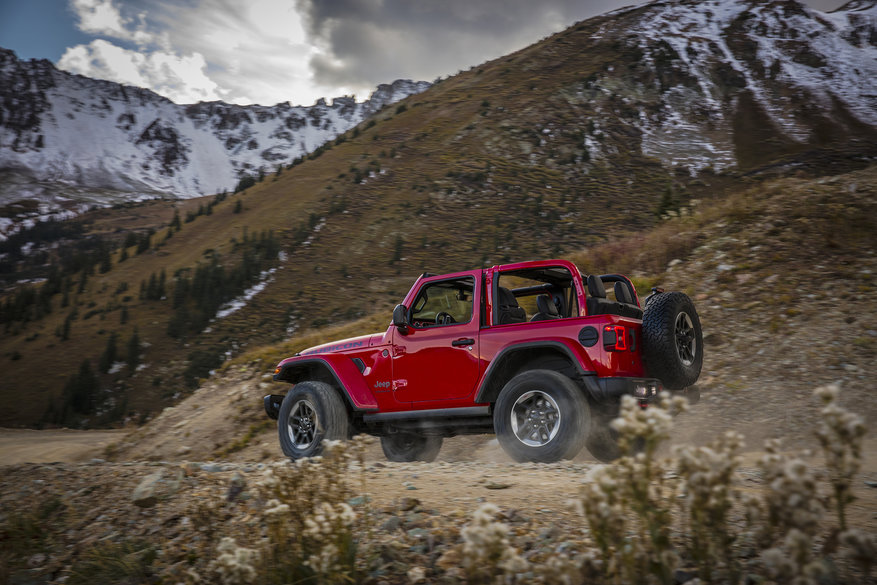LOS ANGELES - It came in growling from stage right. A slate-gray beast of a vehicle that at once looked just like the thing it was replacing, but upon further review was something way more mature, more capable and more refined.
They call it the 2018 Jeep Wrangler JL.
And as that slate-gray Sahara edition crawled up a ramp and onto the stage outside the Los Angeles Convention Center’s main hall last Wednesday afternoon, it marked the end of one era and the beginning of a whole new Wrangler generation.
One destined to become an age filled with growth and advances, all while retaining everything that has made Wrangler, well, a Wrangler.
“Jeep has always represented the ultimate in capability and open-air freedom, and our all-new 2018 Wrangler protects that important legacy and takes it into the future,” said Mike Manley, Head of Jeep Brand. “The all-new Wrangler is instantly recognizable as a Jeep, staying true to the original, yet it is better in every way – delivering even more rugged capability, more ride comfort, more fuel efficiency courtesy of several advanced powertrain options, more interior comfort, more safety and more technology.”
By now, we’ve all seen the JL Wrangler’s revised grill, raked windshield, signal lights on the flares and sculpted body. The pictures are everywhere, but beyond all the visual cues are several other features which may have been missed in the overall presentation.
So here are eight JL Wrangler design details that show there is much more to this new vehicle than just aesthetic features.
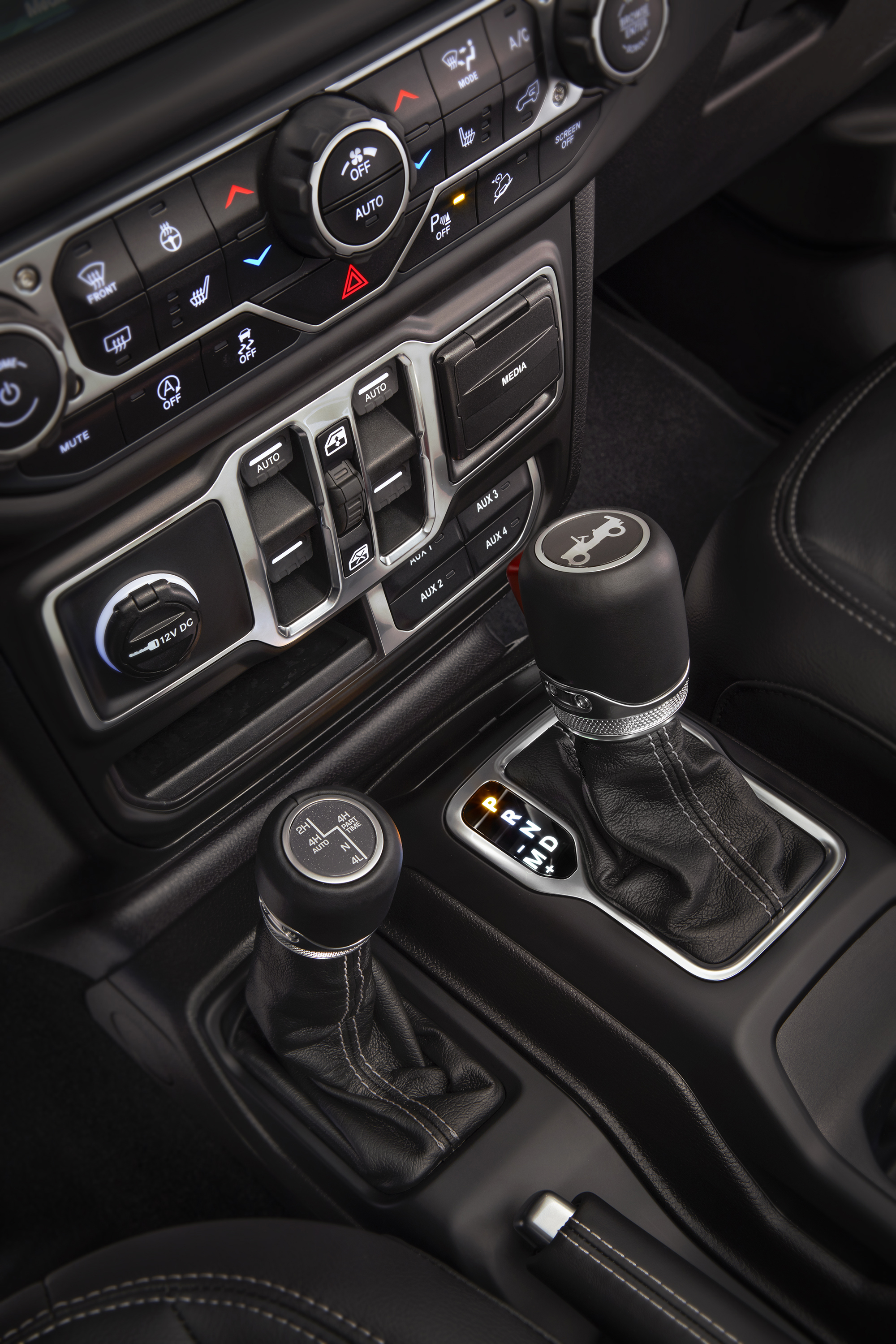
An All New Eight Speed Automatic Transmission
Eight is better than five.
While that may not describe exactly how math works, it does seem to be the case for the new Wrangler JL. Its all new eight-speed 850RE TorqueFlite automatic transmission replaces the JK version’s five-speed and, Jeep says, will increase fuel economy, while adding power and quicker acceleration.
The eight-speed automatic is available on all Jeep Wrangler models, and is designed to optimize engine output on the trail, while providing smooth, efficient power delivery at highway speeds.
According to Jeep, the transmission’s sophisticated system software relies on all kinds of input parameters to determine appropriate driving conditions, then adjusts shift pattern in response so that it can offer the best possible fuel economy and drivability balance. The result, Jeep believes, is automatic shifting ideally attuned to the performance requirements of almost any driving demand.
The Jeep Wrangler’s eight-speed automatic transmission delivers an aggressive first gear ratio of 4.71 for low-end performance and small gear ratio steps to an eighth gear ratio of .67 in order to provide smooth transitions from gear-to-gear. It also has an impressive 77:2:1 crawl ratio when paired with the Rubicon trim level for superior off road performance, as well as a 4:1:1 final drive.
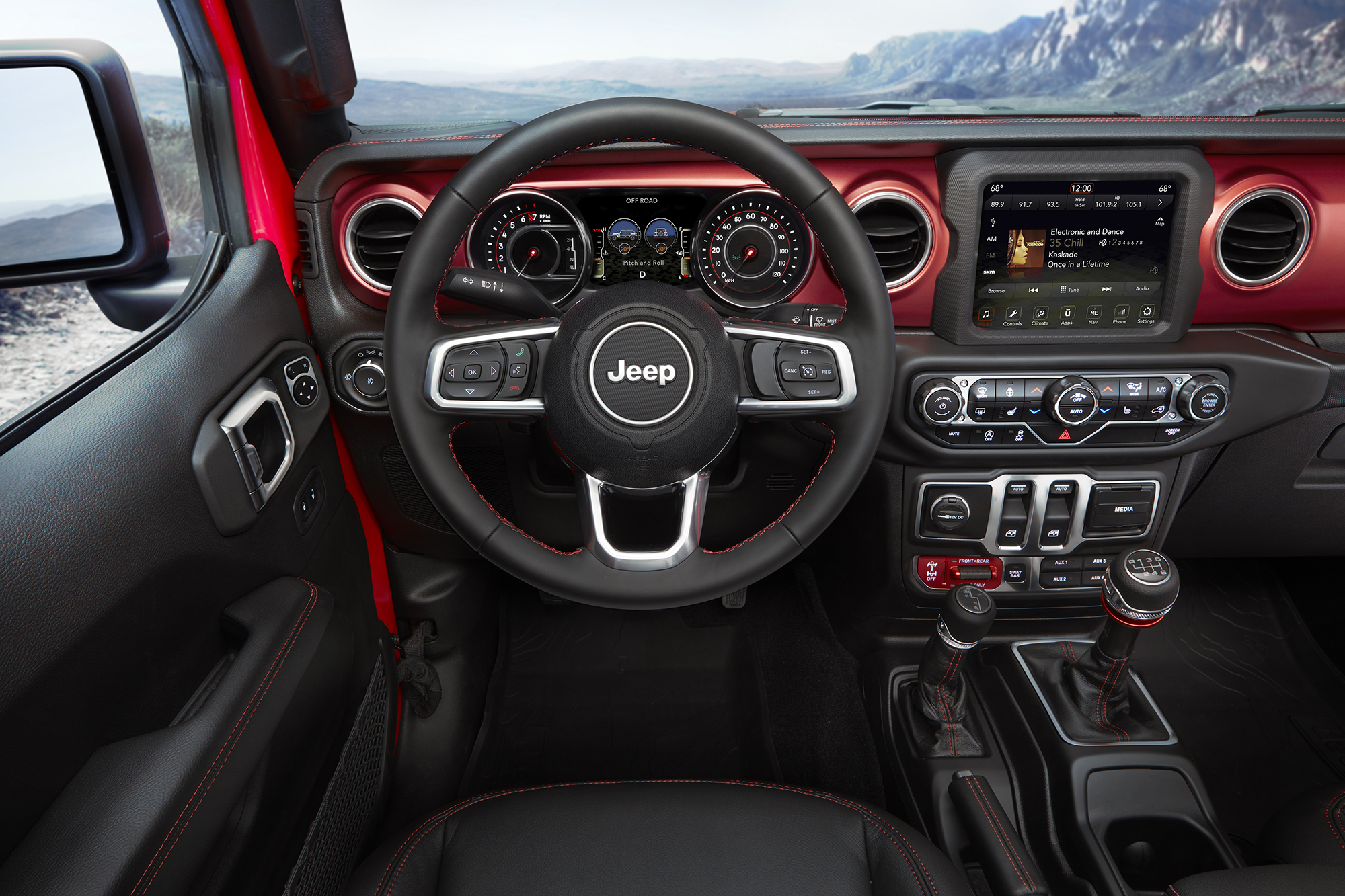
Electro-Hydraulic Power Steering
Not only did Jeep upgrade its transmission for the 2018 Wrangler JL, but designers also made steering a bit easier and more stable thanks to a new electro-hydraulic system.
Previous JK Wranglers used hydraulic power steering which, in part, helped ease steering through the transfer of hydraulic fluid by the vehicle’s speed and amount of torque applied to the wheel. However, the addition of larger tires meant more muscle was needed to steer the vehicle – especially off road.
Electro-hydraulic power steering delivers a more natural steering feel and actually improves fuel economy. The steering system’s pump draws power from an electric motor that activates when it senses driver input and applies a variable amount of torque to assist the driver while steering.
This motor works with an adaptive engine control unit to monitor steering speed, steering wheel angle and vehicle speed. This allows for variable amounts of steering assistance to be applied when more is needed at low speeds, such as when off road, or less when at highway speeds.
The JL Wrangler’s steering knuckles also face outward into the wheel envelopes which improves steering stability while braking and enhances steering input, including bump steer when going over uneven surfaces.
According to Jeep, all this will improve steering stability and overall turning radius to where the vehicle steering wheel can go from lock-to-lock in 3.5 turns for 2-door models and 3.2 turns for 4-door models.
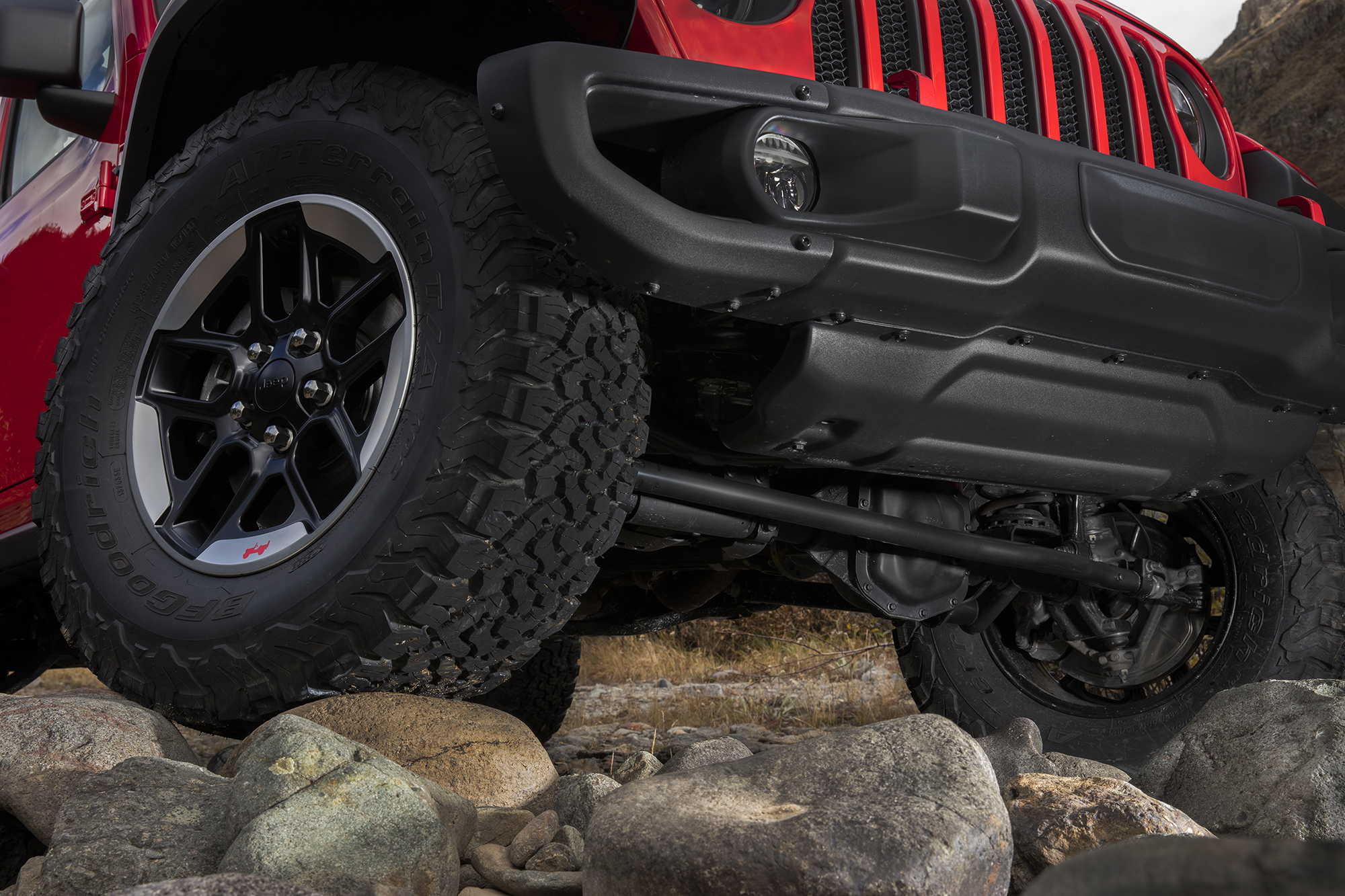
Next Generation Dana Axles
For all three trim levels, Jeep once again contracted with Dana to revise and strengthen the vehicle’s axles using Spicer’s high performance AdvanTEK architecture. These high efficiency axles are designed to deliver maximum power with a smaller footprint, and features high-strength, lightweight materials designed to reduce weight.
Both the Sport and Sahara series will arrive with new solid Dana 30 (front) and Dana 35 (rear) axles that come stock with a 3.45 gear ratio. Other ratios include 3.73 and 4.10, and look to be optional at purchase. These models also come standard with Jeep’s Command-Trac NV241 part-time transfer case, however Sahara does have an optional two-speed MP3022 Selec-Trac (2.71:1) full-time transfer case option, basically giving the vehicle full-time four wheel drive - a first for Wrangler.
The wider Rubicon edition will hit dealerships stock with heavy-duty solid Dana 44 electronically locking axles in the front and rear – both of which will have a 4.10 gear ratio and are slightly smaller than their JK counterparts. This trim level also comes stock with a Rock-Trac NV241 part time, shift on the fly transfer case, with a 4:1 low gear ratio.
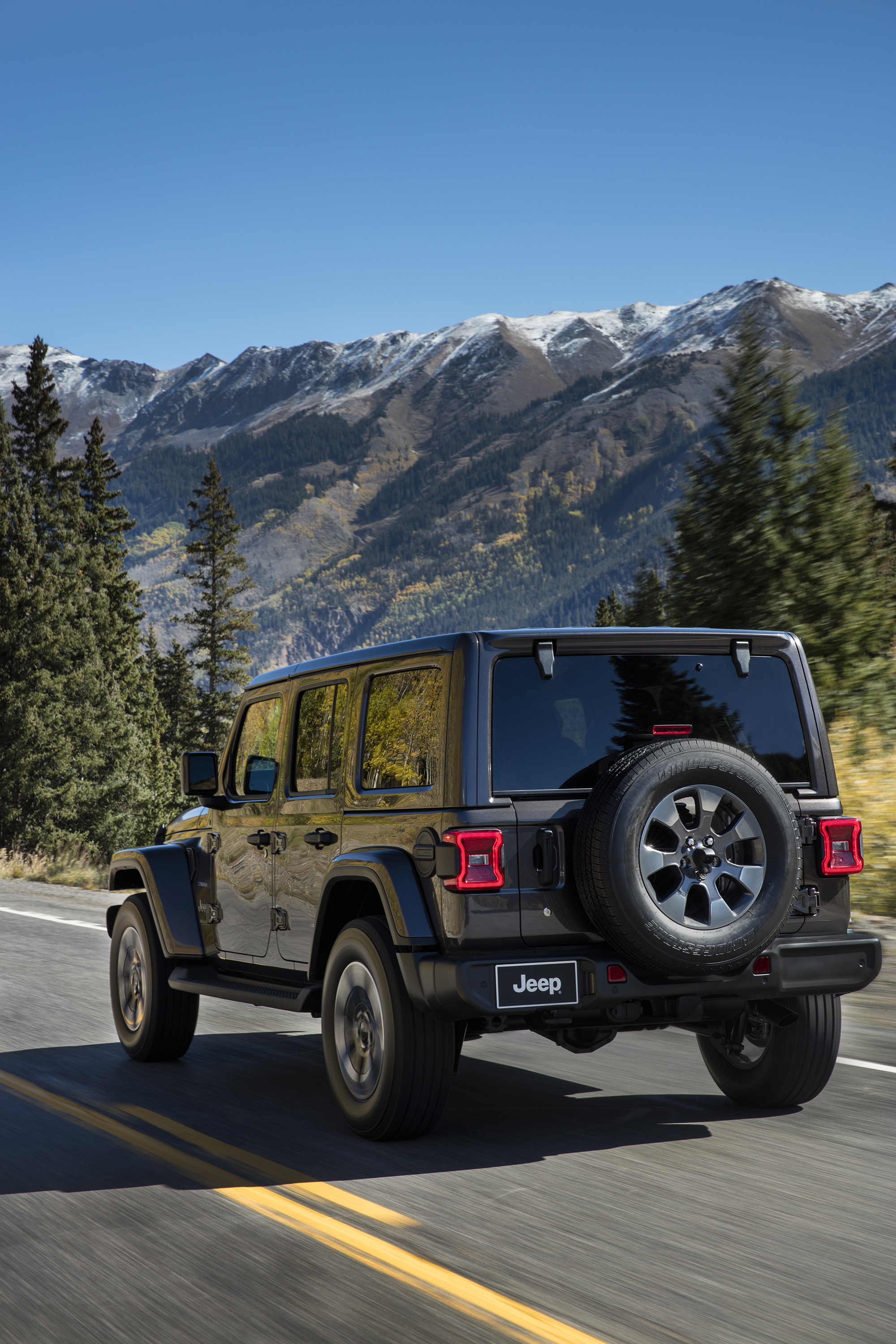
Safety - Blind Spot Monitoring / Rear View Monitor / Rear Cross Path Detection
The 2018 Wrangler JL will take quite a big step forward in safety, and some of its biggest additions are driver-assist related – including a rear view camera and rear cross path detection, as well as an optional blind spot monitoring system.
The new rear view camera, federally mandated for 2018 vehicles, fits through the spare tire and provides a wide-angle view of the area immediately behind the vehicle, giving the driver greater peace of mind when reversing at low speeds. While in reverse, drivers can monitor the camera through their UConnect device and this picture also contains dynamic grid lines to aid when maneuvering into parking spaces or narrow areas. It also aids in lining up a trailer to the vehicle’s trailer hitch, if needed.
An optional Rear Cross Path Detection system is another safety feature designed to assist drivers who are reversing during parking lot situations, or other areas where there may be limited visibility. The system provides an audible chime while also illuminating icons on the side-view mirror should it detect any crossing traffic behind the driver. This also activates any time the vehicle is placed into reverse.
The JL Wrangler’s Blind Spot Monitoring system is optionally available for all trim levels and utilizes dual narrow band radar sensors to aid the driver when changing lanes, or if being passed by or passing unseen vehicles. The system notifies the driver of vehicles in their blind spot via illuminated icons on the side-view mirror, as well as with a driver-selected audible chime.
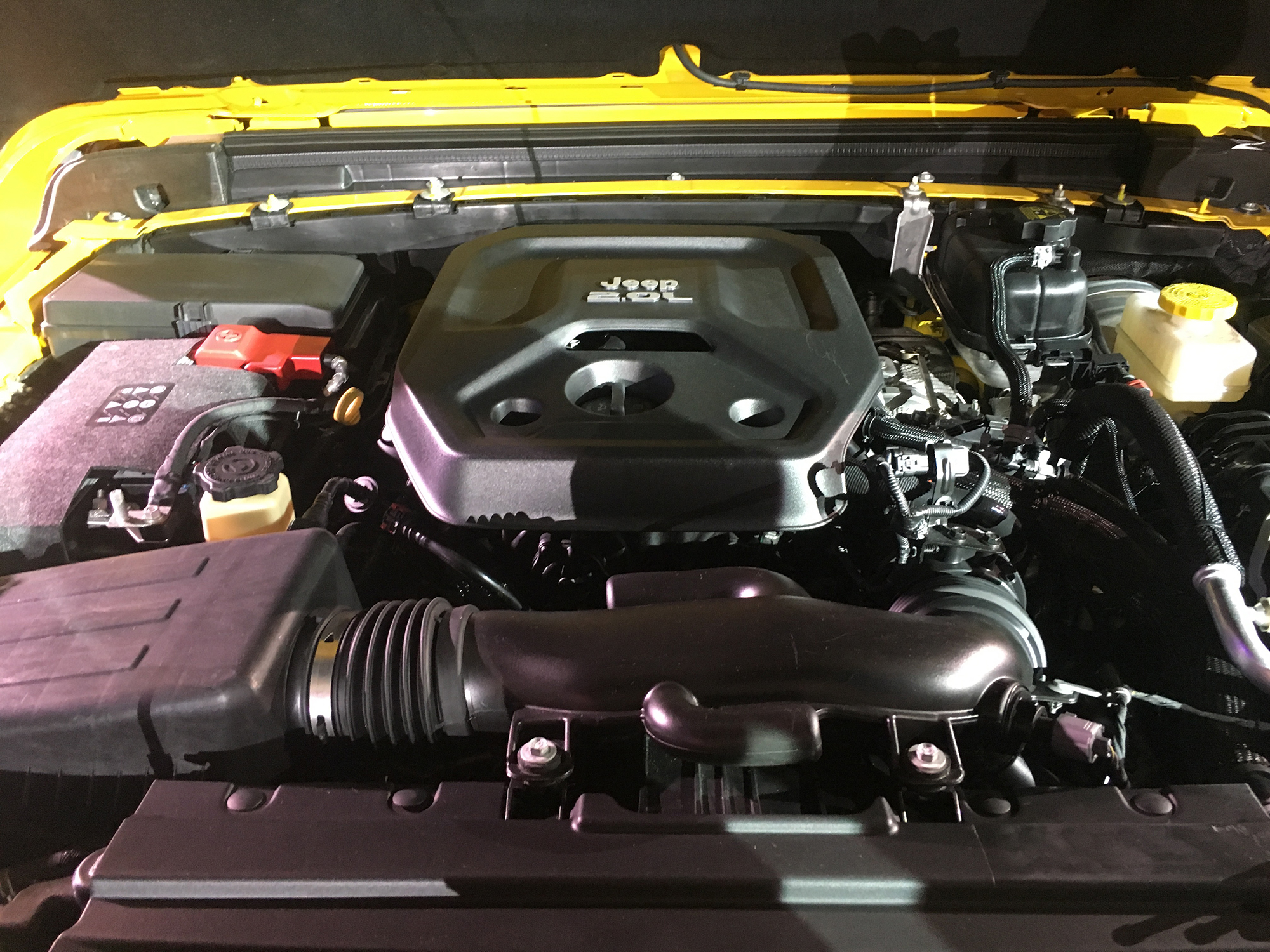
Engine Stop/Start Technology
For 2018, the Jeep Wrangler JL’s 3.6L Pentastar engine will arrive on all trim levels with an Engine Start/Stop system, which basically shuts down the engine and fuel flow when the vehicle brakes to a stop, then restarts both after the brake pedal is released.
This system is driven by a high-speed and high-durability starter, which reduces crank time for quicker restarts. With ESS, acceleration is always aligned with driver inputs where passive accelerator application is met with measured throttle response; harder acceleration triggers aggressive starts. There’s no waiting for either.
ESS essentially works this way: engine controls constantly monitor vehicle speed so when it brakes to a stop, fuel flow is cut and the engine turns off – events that save gas and reduce emissions (improving fuel economy). Stronger batteries maintain other vehicle systems so driver and passenger comfort is unaffected. When the brake pedal is released, the Wrangler JL’s engine automatically restarts – all within 0.3 seconds.
This feature can be deactivated with this push of a button if drivers either do not wish to employ for pavement driving, or plan to take the vehicle off-road. It will re-activate when the Wrangler is restarted.
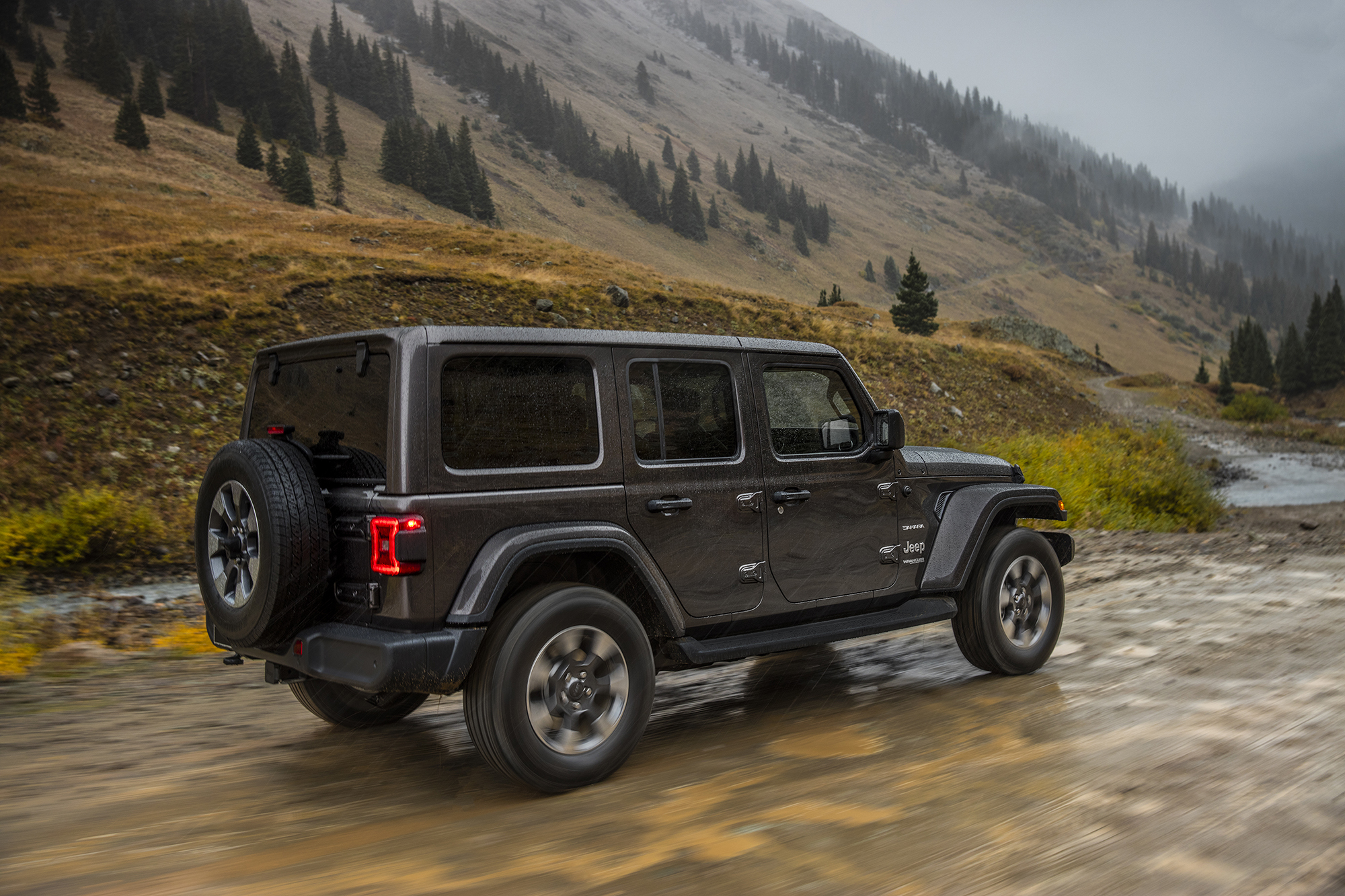
Visibility
One of the bigger complaints about JK (and earlier) Wrangler vehicles is the lack of good visibility through the back and rear side windows. You learn to live with it as a driver, but Jeep engineers decided to actually do something about it on the JL Wrangler.
Behind the vehicle, Jeep lowered its spare tire and – on hardtop vehicles – also changed the rear wiper system in order to open up more visible space through the rear window. They also dropped down the rear seat headrests to provide a bit better visibility through rear side windows. In fact, says Jeep Head of Design Mark Allen, there is more open glass area for visibility that at any point in Wrangler's history.
Not terribly exciting changes, but definitely ones that drivers will appreciate.
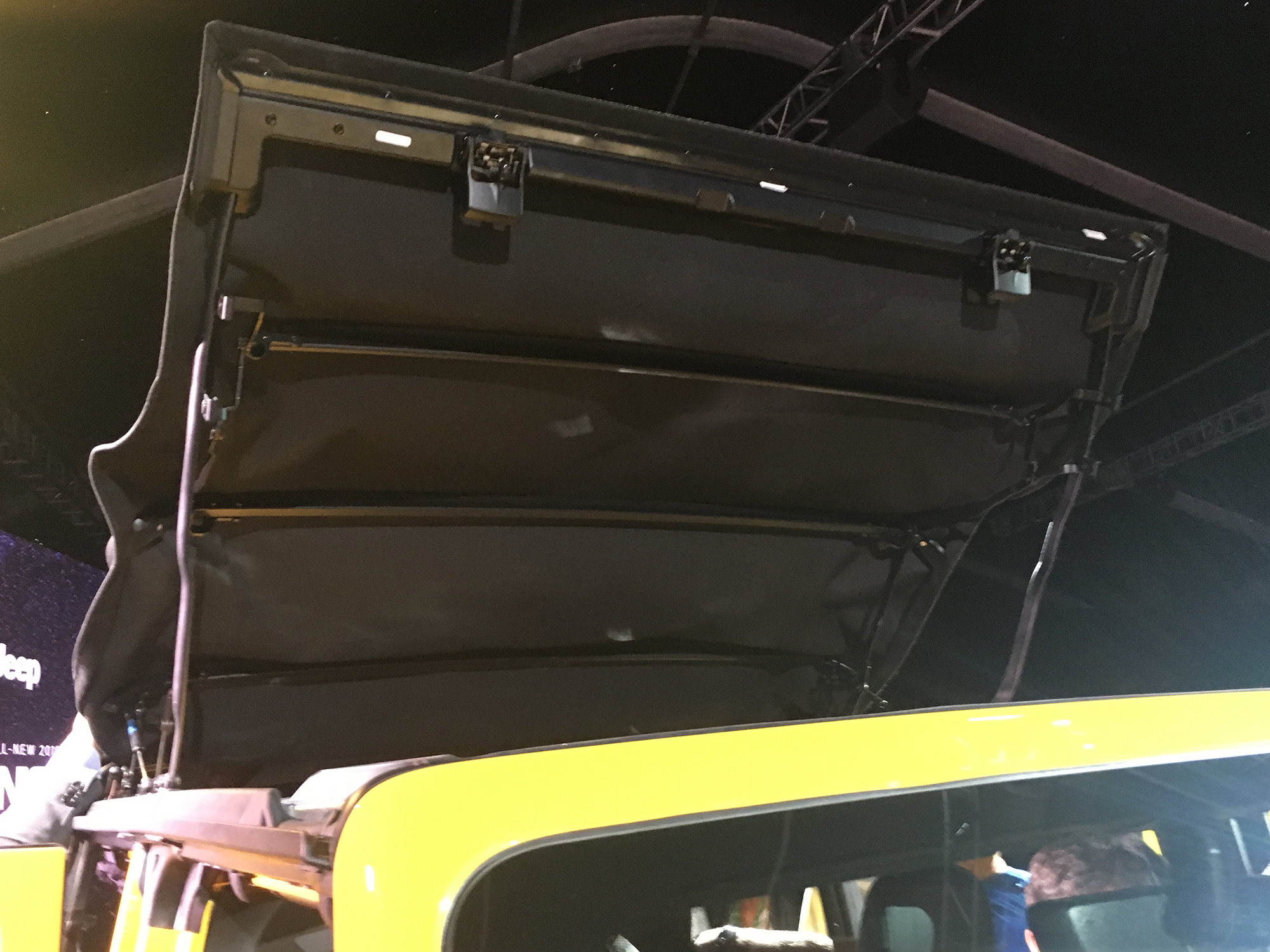
Soft Top Construction and Operation
Struggling with a soft top will most likely become a thing of the past for those who choose this option on their new Jeep Wrangler JL. That’s because hardware and material changes have upgraded the soft top and make it much easier to raise or lower, as well as for removing windows.
”Yes, it’s much more simple now to operate,” Allen said. “We’ve literally taken it down to just a few seconds now to get the top up or down.”
While the JL Wrangler’s Sunrider top still flips back like the JK version, gone are the side hardware clips that must be manually activated in order to fold the top entirely down. For 2018, the Sunrider sits on side tracks which slide back when the top is detached.
If the top is entirely reclined, hardware pieces on both rear sport bars lock it into place, then act as springs to push the Sunrider back up when ready. This allows the user to easily move the top upright, without having to struggle with bulky frame pieces during the process.
Something else soft top owners will no longer struggle with – zippers.
The new Sunrider will now secure its windows via a channel and retaining system, similar to Bestop’s current NX Glide. This means no more fighting with those annoying, and uncooperative, zipper pulls. Especially when it is chilly outside or just about to rain.
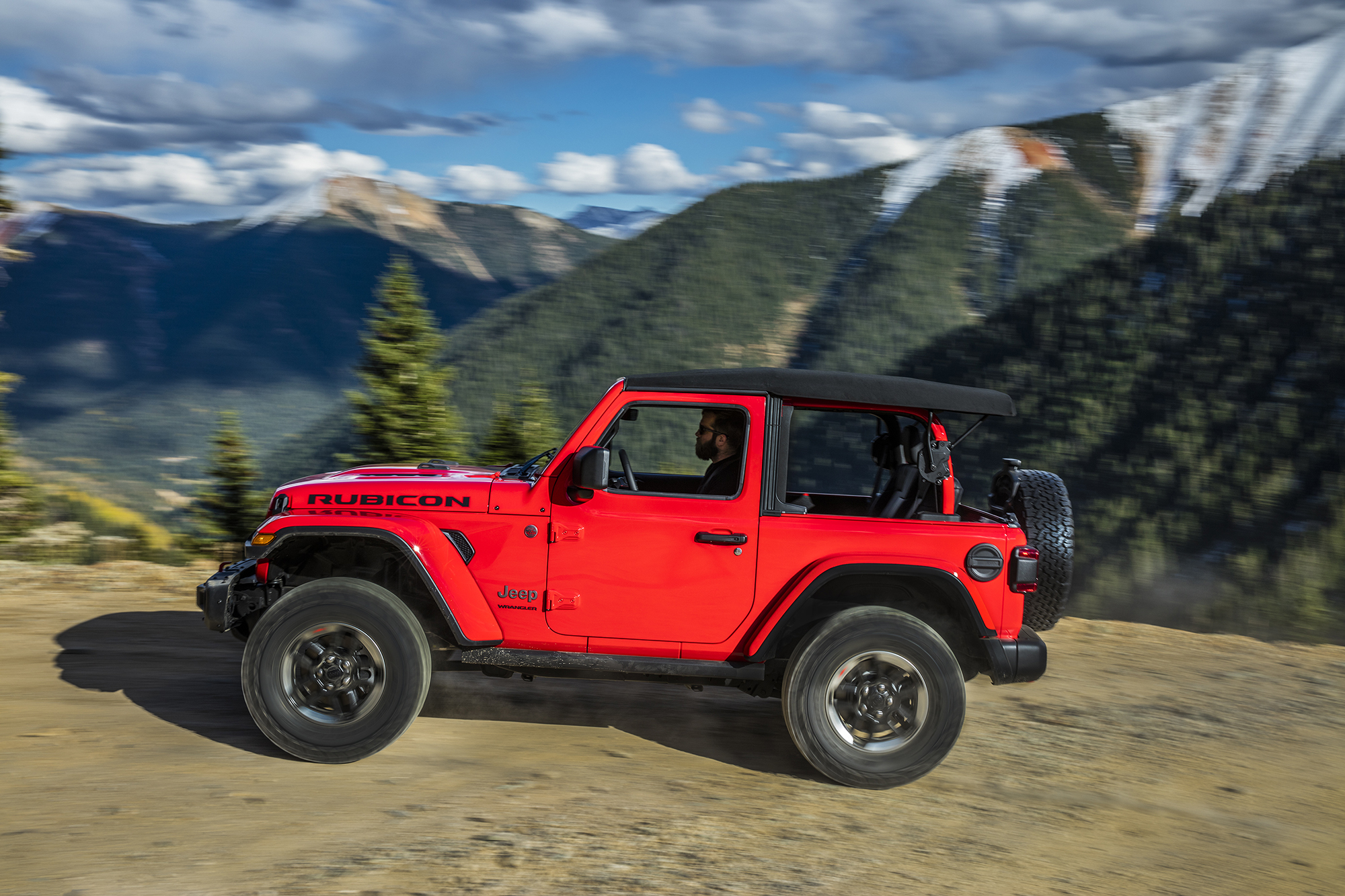
Aluminum
The 2018 Wrangler JL is not your previous steel-infused Jeep animal. While the JL does continue to have steel throughout its body-on-frame construction, engineers have managed to swap aluminum into many pieces in order to remove some weight, while adding strength and rigidity. In fact, switching to aluminum on some parts has helped the JL lose about 200 pounds over the current JK.
Up front, it is the windshield frame and hood that are now entirely aluminum, with the frame even laid back about 15 degrees in order to provide a bit more aerodynamics. Allen said many other designs were mocked up, both with more or less rake, but designers overall felt this 15 degree look was the best. Plus, the lighter frame also folds down a lot easier than in previous incarnations, with just four bolts needed to detach and take down. In addition, engineers raised up the Rubicon trim level's hood and included cowl vents to add airflow into the engine bay. New metallic hood latches now hold down this lighter hood as well, while new functional fender vents should help reduce flutter.
On all trim levels, Jeep is now using aluminum in its Wrangler JL doors, fenders and flares. For the doors, this will not only subtract overall vehicle weight, but will also make them substantially easier to remove and store as needed. Those who constantly swap the doors in and out will certainly appreciate this features. Changing over fenders and flares to aluminum will especially benefit the off road crowd as the added strength should help stand up to most trail obstacles.
Jeep is also employing an aluminum/magnesium mix on the JL Wrangler tailgate, which is also slightly larger. While reducing the weight should make the tailgate a bit easier to swing open, especially for those who choose a larger spare tire, the added strength should prevent the tailgate from warping over time with that larger spare.
-----
The 2018 Jeep Wrangler JL is currently available for order, and should arrive to dealerships later this coming January.
For more on the newest Wrangler, check out our JL Walkaround here.













